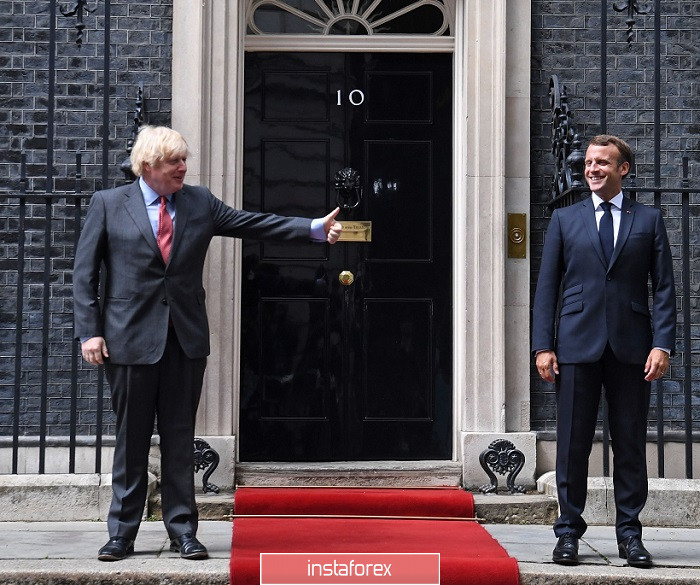The Brexit process is often compared to a difficult divorce process when the former spouses cannot divide the jointly acquired property for a long time. In my opinion, the similarity in this case is manifested not only in essence, but also in form: the parties have already slammed doors several times and announced the completion of the negotiation process, but in the end, they still returned to dialogue. Thus, on Friday morning, EU negotiator Michelle Barnier and his British counterpart David Frost once again announced that they were ending negotiations that had lasted for a week. A few hours later, British Prime Minister Boris Johnson and the head of the European Commission Ursula von der Leyen agreed to resume the dialogue during a telephone conversation. Both parties sat down at the negotiating table on Sunday. However, on Monday, it became known that the negotiations are again under threat of failure.
By and large, on Sunday, the situation has returned to zero. And although this outcome was very predictable, the pound reacted quite violently to the events taking place, reacting sharply to the news flow. So, in the second half of Friday, GBP/USD impulsively broke the 1.3500 mark for the first time since May 2018, amid rumors that the deal will be concluded over the weekend. But at the end of the trading week, the optimistic mood dissipated: the pound again rolled down, stopping at 1.3439. On Monday, the pair started a new trading week with a downward gap. The bearish sentiment still prevails: sellers were able to pull the pair into the area of the 32nd figure, reflecting the panic among investors.

But there is no need to panic. Such 300-point flights are very typical for the pound sterling when it comes to making key decisions about the prospects of Brexit. Remember the price fluctuations that preceded the general Brexit agreement. At the end of last year, such a heated situation was observed in the currency market: the GBP/USD pair overcame more than a thousand points, rising from the 20th figure to the 32nd price level. This growth was also accompanied by deep price reversals, which were caused by negative rumors around the negotiation process.
The situation at present is precisely the same: the deadline is approaching, but there is still no decision on the deal. There are only three weeks left until the end of the transition period, so the market is reacting more sharply to the news flow about the prospects of the negotiation process every day. Even in the absence of news, the market makes certain conclusions. The information vacuum usually plays against the sterling.
The fundamental background for the GBP/USD pair is changing at a kaleidoscopic speed: within a day, the pair can go down for several hours against the background of negative rumors, but then impulsively shoot up, reacting to positive comments from officials. Therefore, it is impossible to assess the short-term prospects of the pair: the market is now too susceptible to emotions.
But if we talk about the medium-term (and even more so long-term) GBP/USD, in my opinion, the priority remains for long positions. The parties continue to rock the boat, trying to find a compromise in the remaining problematic issues. Differences remain over the institutional framework of the legal framework and governance system (the protection of citizens and businesses on both sides depends on resolving this issue), as well as over the regulation of the fishing industry, in particular the preservation of access to fishing in British waters for European fishermen. At the weekend, the influential publication, The Times, reported that the Europeans agreed to soften their position on the issue of level playing field. According to anonymous sources, the leaders of Germany and France agreed to make certain concessions.
However, on Monday morning, the information flow has turned dark. Several news agencies and publications (among them both European and British) reported that the negotiations are under threat of a final breakdown. Initially, it was reported that the most ardent opponent of the British on the Brexit issue, French President Emmanuel Macron, expressed disappointment that the parties could not conclude a deal at the weekend. At the same time, he said he was ready to withdraw from the negotiations and focus on preparing for a Brexit scenario without a trade deal. A little later, the British press reported that Prime Minister Boris Johnson is also ready to refuse further negotiations with the European Union. In addition, according to journalists, every minute counts, that is, by the end of this day, London may withdraw from the negotiation process.
In my opinion, now we are seeing a kind of "game of nerves", or rather its continuation. If earlier the heads of negotiating delegations "slammed the doors", now the leaders of states demonstrate the same behavior. Recall that the French have repeatedly left the negotiating table - both in the past years and this year. But in reality, the negotiation process did not stop (except for temporary pauses).
At the same time, it is possible that Boris Johnson will actually exit the negotiation process today, thereby raising the stakes in this difficult political game. The reaction of the pound sterling in this case will be extremely negative. The GBP/USD pair may go to the base of the 30th figure or even test the area of the 29th figure. But we can't rule out the possibility that against the background of such intentions of the leaders of Britain and France, the negotiators will be able to outline the contours of compromise solutions. In this case, the pound will return the lost positions in just a few hours. Therefore, at the moment, it is better to take a wait-and-see position, in order to avoid a strong drawdown.

If we talk about medium - and long-term prospects, then a return to the 35th figure is likely. The stronger the spring is compressed,the faster it is then released. Many experts still believe that the parties are, figuratively speaking, bluffing. Only in the run-up to the X-hour, when only a few weeks remain before the end of the transition period, the leaders of states have already joined the game, whereas previously such political maneuvers were performed by the heads of negotiating groups.
Thus, for the GBP/USD pair, it is better to take a wait-and-see position at the moment, since the downward corrective impulse is still not over. When the momentum fades, you can consider long positions, counting on the long game (that is, at least we are talking about the average time). Such price reversals are possible in the future, so they must be taken into account when calculating the transaction volume. The target of the upward movement remains the 2.5-year high, which was reached last week – 1.3538. But, I repeat, it is advisable to make trading decisions for the pair after the current downward impulse fades.





















